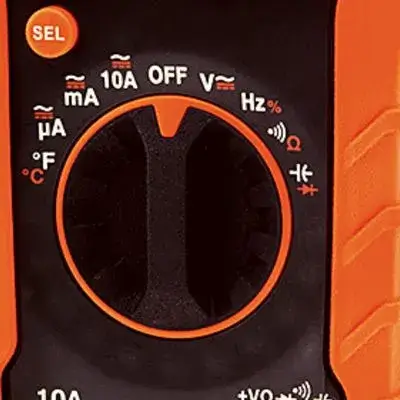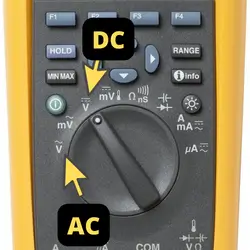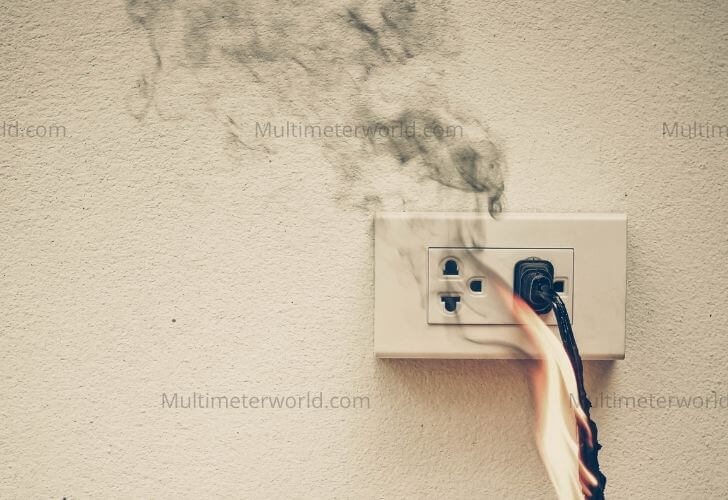Do you know how to find a short circuit with a multimeter? If not, don't worry! In this blog post, I will teach you everything you need to know. A short circuit can be very dangerous, so it's important to know how to identify and fix them. Multimeters are essential tools for every electrician, and today I will show you how to use them properly. But first you should know what a short circuit is and why it happens?
Read more about: Multimeter Symbols and their meanings
What is a short circuit and why do they happen?
A short circuit is a type of electrical fault that occurs when two or more conductors touch each other, causing a current to flow through them. This can cause serious damage to your equipment, and it can also be very dangerous.
Read More about: Best multimeter to measure milliamps
Short circuits can occur for many reasons, but the most common cause is losing of two conductors, wrong wiring, or human error. For example, if you touch two wires together, you will create a short circuit. Read on how to test an electric fence.
How to find a short circuit with a multimeter
Now that you know what a short circuit is, let's take a look at how to find them with a multimeter.
Step by Step Guide:
Step 1: Get the Right tool:
The first step is to make sure you have the right tool for the job. You need a multimeter, it can be an analog multimeter or digital one. But it would be best if you choose the digital multimeter, because digital multimeters have autoranging options. For your convenience, I have made a list of best budget multimeters for you.
Read More about: BEST MULTIMETER FOR ELECTRICIANS
Step Two: turn the multimeter on:
Before you start using the multimeter, you need to make sure it is turned on. On most multimeters, there is a switch on the front panel that you need to turn on. But in the latest digital multimeters, the dial has an off position. So, when you're done with testing you have to rotate the dial in an off position. There is also an option of Auto-shut-off in case of an activity of 15mins.

Step Three: Turn on the device
Turn on the short circuited appliance or device with Series power supply. This will help you in avoiding further damages to the device. If you see spark, flame, heated wires or blown fuses somewhere then turn it off and do the remedy.
Step Four: Physical analysis
If there are no visible burns of the short circuit then you have to check the fuse box. There might be an option that the circuit is not completed. For this purpose Just do a short loop testing of control wiring of broken wire. It can be hot or neutral wires. Always do this kind of loop testing in off condition only.
Moreover, If you want to check the continuity of a circuit component then you can trace the circuit board foil. This foil is basically the PCB Printing. You can trace it easily with a simple continuity test.
Step Five: Check continuity
To perform a continuity test, set the multimeter to continuity mode. Now, put one probe on one end of the wire and touch the other probe to the other end of the wire. The meter should beep if there is a continuity between the probes. If there is no beeping, then that means there is a break in the circuit and you have found a short circuit.

Now you have found the short circuit, so do the necessary repairs and prevent any further damage. Be very careful when working with electricity, and always use proper safety gear.
Common Causes of Short Circuits:
- Damaged wiring: Over time, wiring can become frayed, corroded, or otherwise damaged, resulting in a short circuit.
- Faulty appliances or devices: If an appliance or device has a faulty component, it can cause a short circuit.
- Moisture: Water can damage wiring, causing a short circuit. Moisture can also cause corrosion on electrical connections, which can result in a short circuit.
- Rodents: Rodents can chew through wiring, causing a short circuit.
When to Call a Professional:
If you are not comfortable fixing the short circuit yourself, or if the cause of the short circuit is not immediately apparent, it's best to call a professional electrician. Attempting to fix a short circuit without the proper knowledge or experience can be dangerous, and can result in further damage or even injury.
Safety Guide:
When working with electricity, there are a few safety guidelines that you should always follow. Here are seven tips to help keep you safe:

- Always use proper safety gear. This includes rubber gloves, boots, and eye protection.
- Make sure the area is properly ventilated. The fumes from burning insulation can be harmful to your health.
- Never work alone. If something goes wrong, you need someone to help you.
- Make sure the power is turned off before working on any electrical device.
- Be very careful when working with electricity. A short circuit can be very dangerous.
- Always test wires for continuity before working on them. This will help you avoid any accidental shorts.
- If you are not sure what you're doing, don't try to fix it yourself. Call a professional.
Following these tips can help keep you safe while working with electricity. Follow the steps in this guide to know how to find a short circuit with a multimeter.
Read More about: How to check short circuit?
Consequences of not fixing a short circuit:
There are many consequences of not fixing a short circuit. Some of the most serious ones are:
Fire: A short circuit can easily cause a fire. If there is an electrical fire, it can be very difficult to put out.
Explosion: A short circuit can also cause an explosion. This can be very dangerous and can cause serious injuries or even death.

Electric shock: A short circuit can give you an electric shock. This can be very dangerous and can cause serious injuries.
Damaged equipment: If a short circuit is not fixed, it can damage the electrical equipment. This can be expensive to repair or replace. A short circuit commonly can damage your electrical equipment. So, if you see any flickering lights in your circuit boards don’t take them for granted.

Hazardous fumes: The fumes from a short circuit can be hazardous to your health. They can cause breathing problems, nausea, and even death.
Following these tips can help keep you safe while working with electricity. Follow the steps in this guide to find and fix a short circuit with a multimeter. It is important to take care of any electrical issues as soon as you notice them. You can also hire a professional for electrical repairs.
Read More about: How to check car fuses with multimeter?
How to prevent short circuits from happening in the first place:
There are a few ways that you can prevent short circuits from happening in the first place. Some of the most effective methods are:
Install a circuit breaker: A circuit breaker is a device that helps protect your equipment from short circuits. It will automatically shut off the power if there is a problem. A tripped circuit breaker can direct you toward the location where the short circuit is.
Use surge protectors: Surge protectors help protect your equipment from power surges. This can help prevent short circuits from happening.
Install a ground fault circuit interrupter: A ground fault circuit interrupter is a device that helps protect you from electrical shocks. It will automatically shut off the power if there is a problem.I will make the list of best multimeter under 100$.
Install Fuses: Fuses help protect your equipment from short circuits. If there is a problem, the fuse will blow and stop the flow of electricity.
Following these tips can help you prevent short circuits from happening.
Read More about: How to test an Electric Fence?
Pro-Tips: How to Find a Short Circuit with a Multimeter
- No Tripping Breakers: If your electrical circuit and circuit breaker don't frequently trip, it's time to investigate using a multimeter.
- Resistance Mode: Set your multimeter to the resistance mode for voltage measurements across components.
- Lowest Resistance Scale: Use the lowest resistance scale on the multimeter and touch the probes gently to the component leads.
- Double-Check and Retest: In case of a short circuit, double-check connections and retest to ensure accuracy.
- Secure Com Connection: Make sure the com connection on the multimeter is securely established before proceeding.
- Consider Higher-End Multimeters: For persistent short circuit issues, investing in higher-end multimeters with advanced features can be beneficial.
- Proper Probe Connections: Connect the red probe to the positive port and the black probe to the negative port on the multimeter.
- Mind Metal Parts: Prevent false readings by avoiding contact between the metal parts of the probes and any conductive surfaces.
- Firm Probe Placement: Obtain accurate measurements by firmly pressing the probes onto the circuit's black terminals or wire connections.
- Black Probe for Ground: Use the black probe to touch ground or common points when troubleshooting.
Final thoughts on short circuits testing:
Testing for short circuits is an important part of electrical safety. By following the steps in this guide, you can find and fix a short circuit with a multimeter. Be sure to take care of any electrical issues as soon as you notice them. You can also hire a professional for electrical repairs. If you don't have the right tool then you can also visit my list of best multimeters for electronics repairs. Hopefully this article will help you to stay safe while working with electricity.
FAQs- Frequently asked Questions
Which multimeter is best for electrical circuit troubleshooting?
There are a lot of multimeters, analog and digital. But for electrical circuit or electronics work you need a multimeter which can measure both high and low voltages with high accuracy. Therefore, I have made a list of the best multimeters for DIY electronics work.
Is continuity setting the same in all multimeters?
Yes, the continuity setting is the same for all multimeters. But accuracy may differ from 10 Ohms. To perform the continuity test, rotate the knob to ohms and then select continuity.
Which tool is best for resistance checking, Multimeter or Megohmmeter?
You can also check electrical ground resistance with the help of multimeters. But the best tool for resistance testing is a megohmmeter. I have also made a comparison between Megohmmeter vs multimeter. The typical measuring example for resistance checking is the measurement of a resistor. Read on to learn which tool is best for each kind of measurement.
What is the Impact of Short circuits on a wire or cable?
Short circuits tend to reduce the current carrying capacity of wires. Therefore, you can check a wire quality by its resistance reading. For this purpose all you have to do is to set the multimeter to a resistance setting. Just rotate the selector knob to Ohm sign and touch the probe tips on both ends of the wire. If the electrical resistance is in the rated range of cable then it is good to go. Otherwise you have to change the wire.



